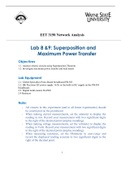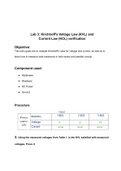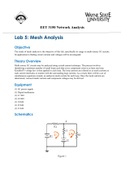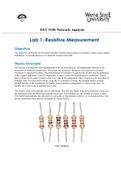EET 3150
Wayne State University
All 21 results
Sort by

-
Network Analysis Homework 1
- Other • 14 pages • 2023
-
- $10.49
- + learn more
This course will cover the topics in electric network analysis and design. Techniques of electric circuit theory are studied and applied in network analysis and design, operational amplifiers, and related circuits, including the applications with NI Multisim, and MATLAB software packages. Analysis of circuits with dependent sources, basic waveforms, RL, RC, and RLC circuit transients and sinusoidal response, network functions, and power analysis

-
Network analysis HW Chapter 4
- Other • 10 pages • 2023
-
- $10.49
- + learn more
This course will cover the topics in electric network analysis and design. Techniques of electric circuit theory are studied and applied in network analysis and design, operational amplifiers, and related circuits, including the applications with NI Multisim, and MATLAB software packages. Analysis of circuits with dependent sources, basic waveforms, RL, RC, and RLC circuit transients and sinusoidal response, network functions, and power analysis
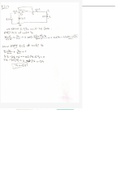
-
Network analysis HW Chapter 5
- Other • 20 pages • 2023
-
- $10.49
- + learn more
This course will cover the topics in electric network analysis and design. Techniques of electric circuit theory are studied and applied in network analysis and design, operational amplifiers, and related circuits, including the applications with NI Multisim, and MATLAB software packages. Analysis of circuits with dependent sources, basic waveforms, RL, RC, and RLC circuit transients and sinusoidal response, network functions, and power analysis

-
Lab 12: Testing and Analyzing Capacitors and Inductors circuits
- Other • 9 pages • 2023
-
- $14.69
- + learn more
The goal of this exercise is to familiarize yourself with the fundamental behavior of capacitors and inductors. The goal of this lab is to experiment with and research the transient behavior of capacitors and inductors (charging and recharging capacitor/inductor networks), as well as to look at simple electrical circuits with parallel/series capacitor/inductor combinations. You should be able to examine circuit behavior when DC or AC voltages are applied to these circuits by the end of this lab....
The objectives of this lab are to verify the nodal analysis concept. Find the circuit node voltages with respect to the ground. In addition to the theoretical calculation of currents and powers for each circuit desig
Analyze electric circuits using Superposition Theorem Investigate maximum power transfer and load match
The objectives of this lab are to verify Kirchhoff's laws for voltage and current and to learn how to measure the total resistance of both series and parallel circuits..
The study of mesh analysis is the objective of this lab, specifically its usage in multi-source DC circuits. Its application to finding circuit currents and voltages will be investigated
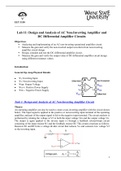
-
Lab:11 Design and Analysis of AC Non-Inverting Amplifier and DC Differential Amplifier Circuits
- Other • 7 pages • 2023
-
- $14.69
- + learn more
In this document ▪ Measure the gain and verify the non-inverted output waveform from non-inverting amplifier circuit design. ▪ Design, simulate and test the DC differential amplifier circuit. ▪ Measure the gain and verify the output value of DC differential amplifier circuit design using different resistance values.
The objectives of this lab are to become familiar with the measurement of resistance values using a digital multimeter. A second objective is to learn the resistor color code.

Did you know that on average a seller on Stuvia earns $82 per month selling study resources? Hmm, hint, hint. Discover all about earning on Stuvia




